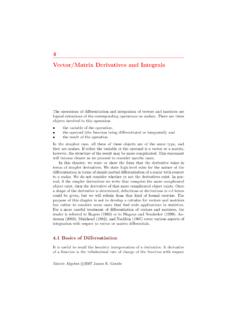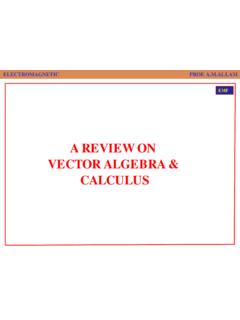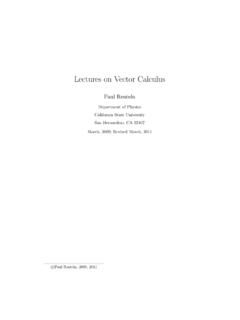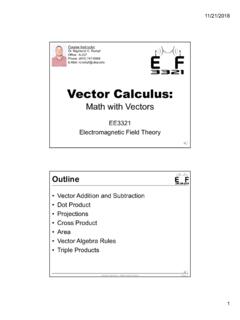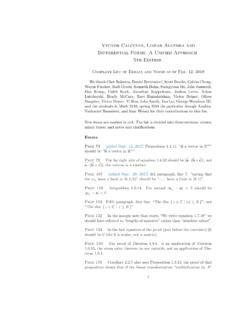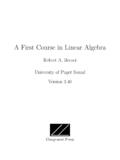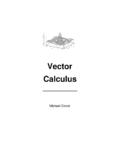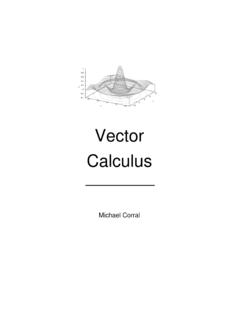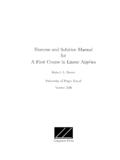Transcription of Math 51000: Vector Calculus (Course No: 21495)
1 1/10 math 51000: Vector Calculus (Course No: 21495) Meets:MW 9:00-10:15a in SL 051 Final Exam:May 5, 8:00-10:00aInstructor:Carl CowenOffice:LD 224 PPhone:278-8846 Office Hours:M 10:30-11:30a and 3:00-4:00p, W 10:30a - 12:30p, or by Information and GoalsCalculus is one of the outstanding intellectual achievements of the human mind, inaddition to being the foundation of many applications of mathematics to physics, chemistry,biology, statistics, economics, and many other natural and social sciences. The roots ofcalculus go back to Eudoxus, Archimedes and other Greek thinkers more than 2000 yearsago, but the Calculus as we know it began with the work of Isaac Newton, Gottfried Leibnitz,and other mathematicians of the 17th century with many improvements in understanding,development of applications, and refinements and extensions of the theory in the 18th and19th century.
2 In math 165 and 166 (or math 163 and 164), you learned how to use the ideasof Calculus to solve many of the problems that Calculus was invented to solve: describinghow quantities change over time, to solve extremal problems, to find areas and volumes,to explore how functions describe natural phenomena, and to describe the structure of , it was clear even in those beginning Calculus courses that what we had learnedwas inadequate because many natural functions were best understood as functions of morethan one independent variable. This course has the goal to develop and understand func-tions of more than one variable in the same kinds of ways that we learned to understandfunctions of one variable in elementary Calculus .
3 While that was also part of the goal ofMath 261, this course will tackle harder problems and develop more effective tools thanwe used in math 261. In particular, we want to develop effective tools to understand theway in which functions of several variables change over time, to solve maximization andminimization problems in several variables, to find areas of curved surfaces, and find waysto describe the structure of such official textbook for the course is:Text: Vector Calculus , Linear algebra , and Differential Forms4th edition(2009), by J. H. Hubbard and B.
4 B. text should be available at the bookstores, but it is also available at the publisher swebsite: there are also solutions manuals andother items (which I have never seen) available at that site. Last year, the course used the3rd edition. There are very few changes between the 3rd and 4th editions, so if you can finda 3rd edition available at a lower price, you may wish to use it. While I will primarily beusing the 4th edition, I have both editions available, so I can alert you to differing problemor page numbers for the homework assignments if you goals for you in this course areShort term goal:That you master the ideas and computations of the course , boththeoretical and term goal.
5 That you recognize the uses or ideas of Calculus as you see themin your professional or your personal life and that you know or can quickly relearn thecomputations that are important to you throughout your as tangent lines and linear approximations related to the derivative are used incalculus to describe the behavior of functions of one variable, multi-dimensional analogs ofthese objects will be used in this course ; these are objects from linear algebra . The linearalgebra bookIntroduction to Matrix Analysis for Engineering and Science,by Carl Cowen (ISBN 0-9650717-6-6)is on reserve in the University library and it covers all of the topics from linear algebra thatwe will need.
6 Similarly, the same is probably true for the book you used in math 351, Math511, math 262, or math 171 if you have taken one of these courses. In addition, , , and of the Hubbard & Hubbard book also cover the topics we willneed. Because we expect that you have had this material before, it will not be a formalpart of this course , but you will need to be able to understand the terminology from linearalgebra (such as Vector , matrix, subspace, span, linear independence, and dimension) andto be able to do the computations related to these objects (such as finding inverses anddeterminants of matrices, solutions of systems of linear equations, and bases for subspacessuch as the image (range) or kernel (nullspace) of a matrix).
7 If you do not know thesethings right now, you should choose a source you find comfortable and learn some of thebasics by January developing schedule for the course will be announced in class, but will also be onthe website for the class (see the URL above), updated you are comfortable doing so, you are welcome to use calculators or computers withMaple,Mathematica, orMatlabsoftware to do your homework. Quizzes and tests,however, will be paper and pencil only; no machines will be will be two mid-term tests, each counting about 20 25% of your grade, and about35% of your grade will come from the two hour final exam given during Final Exam week(May 5).
8 Weekly homework and occasional quizzes will make up the remaining 15 20% ofyour grade. Late homework willnotbe graded for credit and there will beno make-upsfor missed quizzes. In compensation for this policy, your two lowest homework grades andyour two lowest quiz grades will be Important DatesDateJanuary 18Dr. Martin Luther King, Jr. Day, no classesMarch 5 Last day to withdraw with adviser s signature onlyMarch 15 19 Spring Break!! no classesApril 2 Last day to withdraw (permission of adviser and instructor required)May 5 Final Exam, 8:00 10:00aGeneral Academic PoliciesThe work you submit for homework, quizzes, tests, and exams must be your own.
9 Forhomework, you will probably find it beneficial to consult with other students about thematerial and this kind of conversation and collaboration is encouraged. At the end of theconsultation, however, each participant is expected to prepare their own summary of thediscussion and their own solution to the problem. More information about student conductcan be found information concerning adaptive services for learning or other disabilities at IUPUIcan be found policies for this class will be those derived from IUPUI s policies on academicconduct and adaptive course OutlineThis outline describes the topics we will cover in the course , approximately how muchtime we will spend on each topic, and in what order.
10 It is, however, an estimate and theday to day schedule for the course will be announced in class and will be found on thecourse ~ 4 Review of Linear algebra & Limits in several Important basic theorems of ,8 Differentiability in several Implicit & inverse function ,2 Manifolds & tangent Taylor polynomials1 Midterm Test I(late February) Critical points & Constrained extrema: Lagrange Integration in several Fubini s Theorem: iterated 10 Volumes & determinants change of variables in 3 Integration on manifolds1 Midterm Test II(early April) Differential Integrating form fields over parametrized ,4 Integrating forms over 10 Integral theorems of Vector calculus2 Final Exam, May 5, 8:00-10:00a
